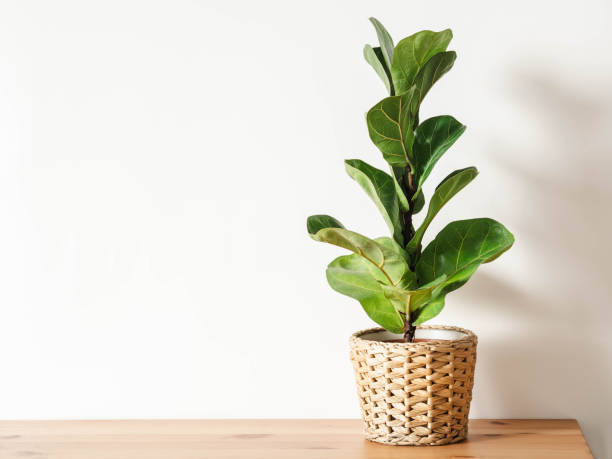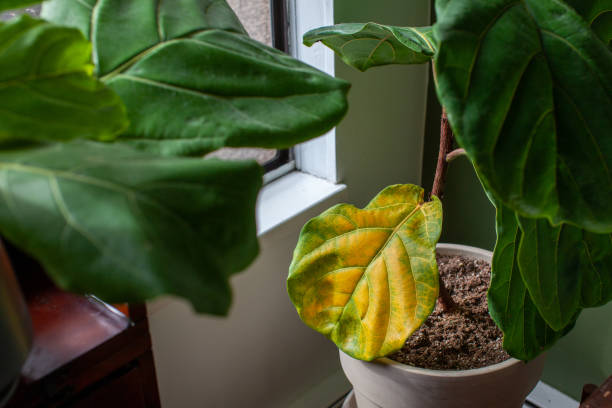
Many new ficus owners find it difficult to determine when to repot their fiddle leaf figs.
Repotting is a vital part of taking care of the ficus species plant known as the fiddle leaf fig.
Repot your fiddle leaf fig at least every two years. Depending on the amount of growth your focus has undergone, whether it needs to be repotted to recover from trauma, or whether it has become rootbound during that time, this period of time may vary.
Use this guide to properly repot these somewhat finicky plants.
Table of Contents
When to Repot a Fiddle Leaf Fig?
Repotting a fiddle leaf fig is typically necessary every one to two years. Repotting your fiddle leaf fig should only be done in extreme cases because they can be somewhat finicky about change and it is thought of as a major change.
Fortunately, a fiddle leaf fig grows best in a pot where the roots fit neatly and snugly, reducing the frequency of repotting.
How Do You Know When to Repot a Fiddle Leaf Fig?
Only when a fiddle leaf fig plant outgrows its current container should you consider repotting it. You should only repot this plant if it becomes root-bound and needs more space for its roots to spread out and grow because it prefers to be quite snug.
Some signs your fiddle leaf fig is root bound and has outgrown its pot include:
When Roots Are on the Surface of the Soil.
It is a sign that your fiddle leaf fig is root-bound if the roots are visible on the soil’s surface, especially if they are growing in a circle inside the pot’s rim. Around the plant’s base, you might notice thick, lumpy roots as well.
When Roots Protrude through the Bottom of the Pot.
The roots of your fiddle leaf fig run out of room to grow when it is root bound. They might then begin to emerge through the drainage holes in the pot’s base. Your fiddle leaf fig is root bound and needs to be repotted if roots are visible coming through the pot’s bottom.
When It Has Compacted Soil.
The roots of your fiddle leaf fig may be occupying more space in the soil than they should if the soil is dry and compacted and is pulling away from the sides of the plant pot. This indicates that the roots quickly absorb moisture from the soil, causing the soil to dry out too quickly. Your plant’s health is compromised by compacted or excessively dried soil because it is unable to receive the nutrients and moisture it requires to grow.
If Its Growth is Stunted.
Roots are unable to supply the nutrients your plant needs to thrive when they outgrow their space in the pot and overgrow. Your fiddle leaf fig may be root bound if it suddenly starts to grow slowly or stuntedly after previously flourishing. However, when your fiddle leaf fig rests after an active growing season in the summer, slowed growth is typical during the fall and winter.

How to Repot Your Fiddle Leaf Fig?
Mixing the Soil
Mix your new soil thoroughly in a larger container, making sure that all of its components are distributed evenly (unless you are just repotting for fresh soil).
This step can always be skipped if you’re using a mix of succulents and cacti.
Lifting the Plant
With extreme caution, pick up the fiddle leaf fig from the base, tip it slightly to one side, and then lift it while wiggling.
Most of the time, this step is effortless. If not, give the pot a squeeze or move it around to see if that helps.
Removing Old Soil
Now gently shake your plant so that most of the old soil comes off. Don’t disturb its roots while you’re doing this.
While it is inevitable that some small roots will break, do your best to avoid harming the large, supporting roots.
Once the soil has eroded, hose the roots to allow the old soil to wash away.
New Home
It is now appropriate for your cherished fiddle leaf fig to settle into its new location.
Spread your prepared soil mixture throughout the new pot before filling it.
Make sure to fill the sides of the plant with fresh soil before placing your plant. For effective absorption and transport, carefully fluff the root ball.
Finishing It Off
The freshly potted plant should also be hydrated by adding some lukewarm chlorine-free water.
For the first month, refrain from fertilizing the plant because it could potentially harm the roots.

How to Care for a Fiddle Leaf Fig After Repotting?
Supply Adequate Drainage
Additionally, poorly draining soil can make your plant stressed and result in leaves falling off. To enable extra water to drain from the soil, make sure the new pot has drainage holes.
It’s crucial that the new soil drains properly. If you need to repot your fiddle leaf fig, make sure to use high-quality soil.
Place Your Fiddle Leaf Fig in Its Normal Location
Your fiddle leaf fig shouldn’t be relocated right now. To ensure that it receives the same amount of light and humidity as where it has been growing, keep it in the same location.
Your fiddle leaf fig will only experience more stress if you move it to a new location after repotting it. Wait a month or two after repotting your plant before moving it to a new location to give it plenty of time to recover.
Remove Dead Leaves from the Plant
Removing the drooping, dying leaves from your fiddle leaf fig plant will assist in its recovery if this happens, as it occasionally will. This motivates the plant to exert energy into developing wholesome, new growth.
Reasons to Repot Your Fiddle Leaf Fig
To Refresh the Soil.
To give your plants healthy soil, the soil in your plant pot may become depleted of nutrients and may need to be refreshed. Every two to four years, repotting is usually necessary to replace the soil.
To Give Roots Room to Grow.
Fiddle leaf figs have a tendency to get root-bound and outgrow their containers. Repotting is required when this happens. To give roots room to expand, choose a pot that is 1 to 2 inches larger than the current pot.
To Treat Diseases.
When your fiddle leaf fig develops a bacterial infection or a fungal disease like root rot, the plant needs to be repotted in order to remove the offending soil and trim away any dead or diseased roots.

Why is My Fiddle Leaf Drooping After Repotting?
Your fiddle leaf fig’s drooping leaves are typical after repotting. This is because fiddle leaf figs are susceptible to shock when they undergo change, and they frequently respond to stress with the transplant or root shock. As a result, there may be drooping leaves and even some that turn yellow and fall off the plant, though this is only transient.
A significant change for the plant is repotting your fiddle leaf fig. Practically speaking, this means that your plant responds by producing drooping leaves because it dislikes having its roots disturbed. But don’t worry, it will quickly recover once it has a few weeks to acclimate to its new pot.
Can I Repot My Fiddle Leaf in Winter?
When your fiddle leaf fig is actively growing is the ideal time to repot it. Therefore, unless it is absolutely necessary, it is not a good idea to repot a fiddle leaf fig during the winter.
Your fiddle leaf fig spends the winter months resting after a season of vigorous growth. In general, new growth slows down from fall to spring.
Despite that, some reasons you may need to repot your fiddle leaf fig in the winter include:
• addressing illnesses, such as root rot in your fiddle leaf fig.
• Your plant’s roots are very tightly bound.
• You should replace the soil in your pot because it is not dripping properly.
Can I Repot My Fiddle Leaf in Summer?
You should repot your fiddle leaf fig in the spring and summer. It will recover more quickly and suffer less root shock, leading to more robust new growth.
Summertime is a time of active growth for most plants, including fiddle leaf figs. They are most active and best able to adapt to changes, such as repotting, during this time.
Best Times of Year to Consider Repotting
Early in the spring, as the growing season begins, repotte your fiddle leaf fig. Repotting can shock a plant, so the faster it can recover from any potential harm, the better.
You can repot at any time of the year if you need to do so urgently due to stunted growth or pest and disease problems. In these circumstances, repotting is preferable to waiting for the plant’s health. To prevent future growth issues, be cautious when doing so.
Summary: Every One to Two Years
To stimulate growth and enhance the health of your fiddle leaf fig plant, repotting may be all that is required. Remember that unnecessary repotting should be avoided, but you can’t put off doing so indefinitely, especially if your fiddle leaf fig is developing normally.
Yes, it might not be overly excited about it at first. Give your plant the time it needs to adjust to its new environment, though, and you’ll see it bounce back to its healthy, thriving self in a matter of weeks.